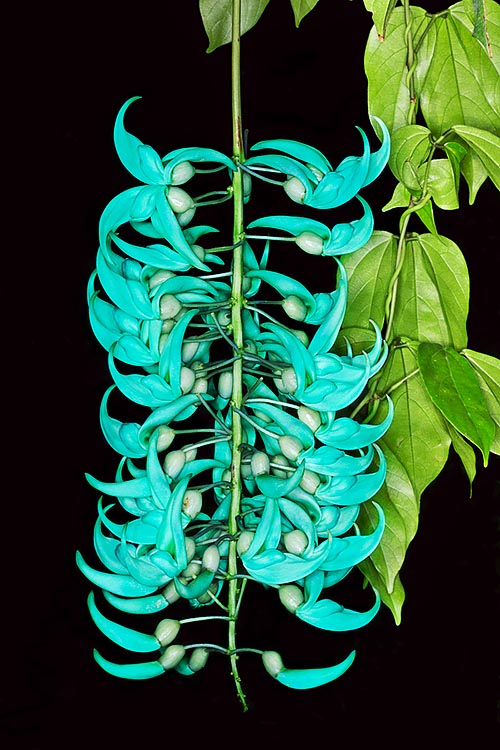Family : Fabaceae

Text © Pietro Puccio

English translation by Mario Beltramini

Strongylodon macrobotrys can be 16 m tall with woody climbing stems. Spectacular jade green drooping inflorescences even 1,5 m long © Giuseppe Mazza
The name of the genus is the combination of the Greek adjective “στρογγύλος” (strogghilos) = rounded and of the substantive “ὀδούς” (odus) = tooth, with reference to the rounded lobes of the calyx; the name of the species is the combination of the Greek adjective “μακρός” (macrόs) = long and of the substantive “βότρυς” (bόtrys) = cluster, with reference to the long inflorescence.
Common names: blue jade vine, emerald creeper, Gray’s jade vine, jade climber, jade vine, turquoise jade vine (English); tayabak (Tagalog); cascade de jade, liane de jade (French); fiore di giada, liana di giada (Italian); flor-de-jade, trepadeira-filipina, trepadeira-jade (Portuguese-Brazil); flor de jade, parra de jade, parra esmeralda, parra de jade turquesa (Spanish); Jadewein (German).
The Strongylodon macrobotrys A.Gray (1856) is a woody evergreen climber that may reach 12-16 m of length with stems of 3 cm and even more of diameter. The leaves are alternate, trifoliate, with oblong-ovate coriaceous leaflets with thinned apex and entire margin, 7-12 cm long, of dark brown colour when young, then glossy dark green. Racemose inflorescences at the axil of the leaves of the ripe branches, hanging, up to more than 1,5 m long, with peduncle and rachis of dark purple colour, carrying numerous hermaphroditic flowers, up to 8 per each node on a 2-4 cm long pedicel, shaped like a claw bent upwards, 6-12 cm long, of bluish jade green colour, with campanulate calyx, about 1 cm long, with 5 rounded lobes; the flowers, rich of nectar, are pollinated by the bats. The fruits are ovate-oblong legumes, 10-13 cm long and of 6 cm of diameter, containing 6-12 reniform brown, 3-4 cm long, seeds.
It reproduces by seed which must be interred as soon as possible as it has a short lasting germinablity, 1-2 weeks, in organic loam with addition of siliceous sand per a 30% maintained humid at the temperature of 25-28 °C, with the first blooming starting from the third year of age; it can reproduce also by semi-woody cutting with bottom heat and by air layering. Vigorous and fast growing climber, it is considered as one of the most spectacular due to the colour, almost unique in the vegetal world, the blooming, practically continuous at the tropics and the long lasting, 3-4 weeks, inflorescences, cultivable in the humid tropical and subtropical climate zones where temperatures under the 10 °C are exception of short duration. It requires full sun and draining, acidic or neutral, soils, and regular and abundant waterings, but without stagnations; regular prunings help in containing its exuberant vegetation and in favouring the blooming. Its ideal collocation is on robust pergolas, which it quickly covers, where the drooping inflorescences would have the maximum emphasis, but it can be grown as climber on trees, as in the wild.
Where the climate doesn’t allow the continuous permanence in open air, it can be cultivated in particularly luminous greenhouses and winter gardens, with lowest winter temperatures not under the 15 °C, in capacious containers using a loam rich of organic substance, sandy, with regular waterings in summer, more spaced in winter, leaving the surface layer of the loam to dry up before giving water again, and fertilizations in spring-summer with balanced products with microelements under form of chelates. It may be subject, in particular in protected ambient, to mites and mealy bugs’ attacks, to be treated with specific products in case of serious infestations.
Synonyms: Strongylodon warburgii Perkins (1905); Strongylodon megaphyllus Merr. (1915).
→ To appreciate the biodiversity within the family of FABACEAE please click here.
